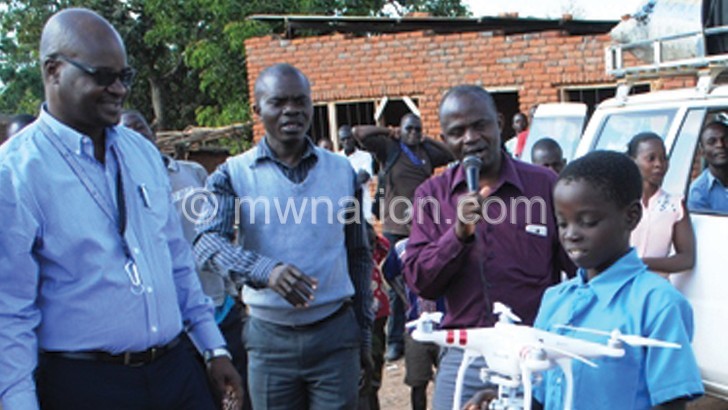Delight in drones
Noah Chipeta is a health surveillance assistant (HSA) at Chathunthu in the area of Sub Traditional Authority (STA) Chitanthamapiri in Kasungu.
Chipeta is a hard working man who is always there to assist those who seek medical help and other health assistance.
At Chathunthu Village Clinic where Chipeta works, there are several services that are provided. They include immunisation, family planning, Malaria Rapid Diagnostic and growth monitoring.
Accessing Chathunthu has its own problems. The roads are not in good shape and during rainy season, the situation is even worse because a washed road network leaves the area completely cut off from the rest of Kasungu.

Mobile connectivity is also a big problem. There are specific places where people go just to get mobile phone network.
To say the least, Chathunthu is an Island on land.
Chipeta narrates the problems that are there because of Chathunthu’s geographic position. Chief among these is long distance to access health services.
“The nearest health centre is at Gogode which is 16 kilometres (km) from here. But the road is too bad. If I have to go to the same health centre using another road which is a bit better then the distance is three times more.
“To keep this clinic running, I need medical supplies. I use a push bike and in some places I have to carry it on my back because of poor roads,” he says.
Transporting medical supplies to the remotest areas has always been a problem as this depends on facilities and resources like a good road network, good vehicles and fuel.
With technology advancement, several ways are being explored to minimise transportation of things, including medical supplies.
In December 2016, the Government of Malawi and the United Nations Children’s Fund (Unicef) announced the launch of an air corridor to test potential humanitarian use of unmanned aerial vehicles (UAVs), widely known as drones.
The air corridor centred on Kasungu Aerodrome, with a 40km radius is now ready. The test corridor has been designed to provide a controlled platform for the private sector, universities and other partners to explore how drones can be used to deliver services that will benefit communities.
If the tests are successful, the problems that Chipeta is facing can well be sorted out.
Initial tests that were done in Lilongwe proved that drone technology has many areas of applications for child health, according to Unicef representative to Malawi Johannes Wedenig.
“One of the applications that we already tested here in Malawi is to transport infant blood samples to laboratories for HIV testing in order to cut the time it takes to get HIV test results,” he says.
“If this happens, it is more likely that clinics in remote areas can follow up with mothers because it is essential to get a child on to treatment if the result is positive.”
Wedenig also highlights the other possible areas of applications or how drones could be deployed to do real work in Malawi.
They include taking aerial footage during disasters to assess situations and providing connectivity for mobile reception so that village health workers or other sectors can communicate with officials at the district council on various issues taking place in their communities.
However, Wedenig says they are still exploring other potential functions.
“We do not know exactly what could be future uses of drones in Malawi. That is why we have this testing corridor to explore that.
“But currently, we are sure of the three possibilities; aerial imagery, connectivity and transport,” he says.
During the launch of the testing corridor in Kasungu recently, Minister of Transport and Public Works Jappie Mhango highlighted the potential use of drones in various sectors, according to Unicef official website
“Malawi can benefit from UAVs in areas of transport, health, education, land surveying and humanitarian situations, and we hope UAV operations can be extended to other areas too,” Mhango is quoted as saying.
Already, some individuals and private firms in the local video and film production industry in the country are using drones for aerial video and photography.
Across the globe, deployment of drones for real work is well advanced. They are being used for surveying and mapping, inspection, science and research, security, monitoring, search and rescue.
A prospect that drones can be used for humanitarian purposes has excited many communities in Kasungu starting with Chipeta himself.
“Imagine the little time it will take to transport medical supplies to Chathunthu. I wish the use of these drones could start as soon as possible.”
Twelve-year-old Yamikani Banda of Chidzenje Primary School in Traditional Authority (T/A) Lukwa believes that he will one day see how his school looks from the sky.
“I will be able to draw a very good map for my school and the surrounding areas,” says Yamikani.
Area development committees (ADCs) also see a very bright future in drones as observed by Chilowamatambe ADC chairperson Yamikani Tembo who says the drones can come in handy when they want to send reports for urgent attention.
“We sometimes want to send reports to the district council. But due to transport problems, we fail to do so in time. I hope the drones can help to lessen this problem,” he says.
STA Mphomwa is also encouraged that the drones will perform more developmental tasks in the communities.
“I feel the drones will help us have the ability to deliver services to the people we serve. All sectors like health, agriculture, environment and education will benefit,” says STA Mphomwa.
The drone testing corridor in Kasungu, which has been ready since June 29 this year, will see unmanned aircrafts being tested for a year. For people like Chipeta, the success of the tests will always be good news. n





